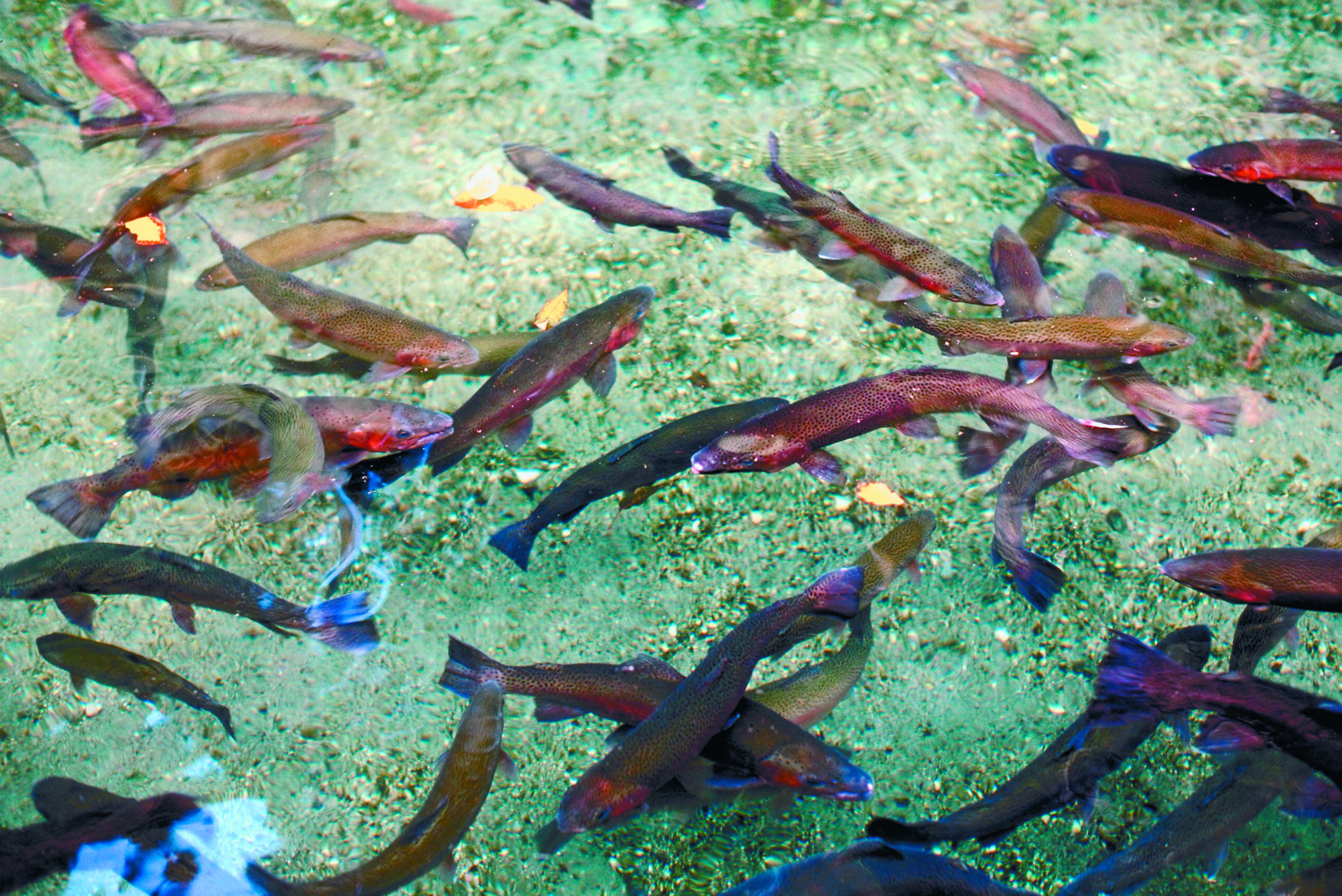Wasson Creek is tiny. If you drive over it on Highway 141 near Helmville, Montana, in the Blackfoot River valley, you likely wouldn’t recognize it as a creek, except for the serpentine swath of willows and cottonwoods that mark its course. Its banks are so thick with vegetation that, if you whizzed by at highway speed, you probably wouldn’t even notice any water at all.
Despite its humble appearance, Wasson Creek has become a key piece in the effort to restore native trout in this middle reach of the Blackfoot River. Decades of human activity have compromised this fishery, consequently reducing the fish population in the Blackfoot for several miles below its confluence with Nevada Creek. Low flows, high temperatures, and nutrient pollution are some of the challenges facing restoration of Nevada Creek.
Luckily the efforts of landowners on two tributaries of Nevada Creek—Wasson Creek and Spring Creek—mark a promising start on the larger middle Blackfoot restoration effort. Spring Creek has recently been restored from a livestock-damaged, shallow, warm stream to a clean, cold pulse of water running year-round into the lower reaches of Nevada Creek. But even restored, Spring Creek was not as productive a fishery as it could be.
That’s where Wasson Creek comes in. Wasson Creek has taken its share of knocks. The creek has suffered from straightening, irrigation depletions, and grazing. But the reach of this small creek above the irrigation diversion is home to a robust population of pure-strain westslope cutthroat trout. This fish was once the most plentiful and widespread of the cutthroat subspecies in the West, but currently occupies only a quarter of its historic habitat. Native fish in Wasson Creek represent a promising seed source for Spring Creek, Nevada Creek, and eventually the Blackfoot. The problem is that, until recently, irrigation diversions de-watered lower Wasson Creek to the point that cutthroats could not migrate down to the newly restored Spring Creek.
For the past few years, however, the Mannix Brothers Ranch, the primary owner on Wasson Creek, has partnered with Trout Unlimited (TU), the downstream landowners, and several state and federal agencies, on a comprehensive restoration effort. An integral part of that effort was to restore flows in the creek’s lower two miles. But the Mannix Brothers Ranch needed irrigation and water from Wasson Creek to provide grass for its cattle.
Working with TU, the ranch came up with a solution that allows them to continue their spring irrigation, while keeping flows in the creek in late summer. It is a water lease—where a portion of the irrigation right is dedicated to instream flows. With funding from the Columbia Basin Water Transactions Program, TU pays the ranch for its lost pasture production from foregoing late-season irrigation and keeping 0.5 cubic feet per second (cfs)—about 224 gallons per minute—flowing in the creek. For Dave and Randy Mannix, it was a question of balance. A water lease with TU gave them the flexibility to restore the stream while maintaining an economically viable agricultural operation. The results were immediate. In the fall after the first season of the water lease, westslope cutthroat turned up in Spring Creek for the first time in decades. Trout Unlimited and the Mannix Brothers Ranch now have a ten-year water lease to maintain flows in Wasson Creek, helping to bring back the native fish.
Water Leasing 101
The Montana water leasing statute allows one to lease agricultural irrigation rights in order to improve stream flows. Water right holders can also convert their water right to instream flows without entering into a lease with anyone, by changing the use of their water right to an instream use with Montana’s water permitting agency, the Department of Natural Resources and Conservation (DNRC). Leases and private conversions can run for up to ten years with a possibility of renewal.
The private water leasing statute includes a number of elements to assure that other water right holders are protected. The applicant for a change to instream flow must identify the length of stream to be protected, and must prove that the rights of other water users will not be adversely affected. In addition, other water right holders are allowed to object to the lease even after the DNRC has approved it, which means that if another water rights holder did not anticipate an adverse effect there is a chance to raise that concern after the water lease is in place.
An instream flow lease takes several years to secure. In most cases, TU first identifies a stream in which low flows are a limiting factor to fish, and looks at how irrigation is affecting the flow. Second, TU must negotiate a water lease with a willing water rights holder. Third, the landowner (with TU’s help) applies to the DNRC for the approval of a change to an instream use for all or part of the leased irrigation right. Finally, the DNRC reviews the water right and proposed changes, and either approves or denies the proposed lease.
Leasing Lessons Learned
Ten years of practical experience has shown that while water leasing can create excellent results for trout habitat, it also has limitations. Changing an existing water right to an instream use won’t always deliver water to a stream. Water rights on a very dry stream can often be complicated, making it nearly impossible to set up a workable system. Just the right combination of seniority of the water right, location of the diversion, the amount of water to be left instream, the condition of the stream itself, and the willing participation of the irrigator all play a part in a successful water lease.
Experience has also shown that water leases are most effective on tributaries, as opposed to mainstem rivers. In many locations in the state, they are quite literally the spawning and rearing factories for wild fish. More than a decade of research on the Blackfoot River, for example, shows that where the tributaries are healthy, the mainstem fish populations are fine; when the tributaries are impaired, the mainstem fish populations are poor.
On most tributary streams, the amount of water necessary to provide good spawning and rearing habitat is relatively small. As a result, a little bit of water in a tributary can go a long way in restoring a fish population, as in our 0.5 cfs story about Wasson Creek. On the other hand, it has not been cost-effective to pursue a change for a water right on a mainstem river where it is difficult to measure the additional flow, and even harder to determine its contribution to the fishery.
Another restraint on the leasing program is that, unlike conservation easements, water leases are not tax deductible. Making leases tax deductible could help to increase participation, but the leases would have to share some of the characteristics of a conservation easement—permanency and a full-property interest—before landowners could receive tax benefits from either the state or federal government.
A final lesson from TU’s experience in water leasing is that instream flow changes work best when they are integrated with other habitat restoration. If flows are improved on a stream channel that has been degraded by other activities, the lease may not achieve its intended result. Water leases and changes to instream uses are proving to be most valuable in cooperative watershed efforts where habitat restoration and enhancement are occurring.
On the North Fork of the Blackfoot River, for example, a multi-year, multi-faceted project is underway to restore native trout habitat in the lower 5.6 miles of river. The effort includes screening irrigation ditches, habitat restoration of tributary streams, and water leases to restore flows. In the case of the North Fork, no single water right is sufficient to fully re-water the river. As a result, the watershed group is working with several irrigators to improve stream flows at key times of the summer and fall, while maintaining ongoing agricultural operations. Trout Unlimited has worked on two water leases with irrigators on the North Fork, as well as a rancher on an important North Fork tributary, Rock Creek. The North Fork restoration provides yet another example of where the whole is greater than the sum of its parts, and water leasing is but one of many important pieces.
Portions of this article have appeared in TU publications, “A Buyer’s Guide to Montana Water Rights” by Stan Bradshaw, and “Private Water Leasing: A Montana Approach,” and are used here with the permission of the authors: Laura Ziemer, Director, Montana Water Project—Trout Unlimited, and Stan Bradshaw, Program Attorney, Montana Water Project—Trout Unlimited.




